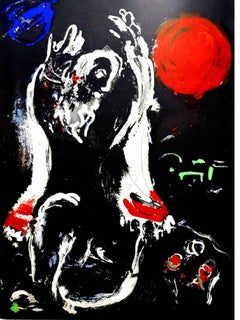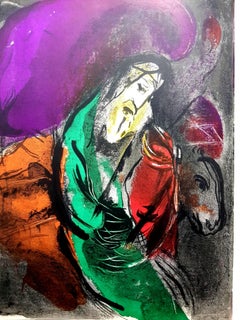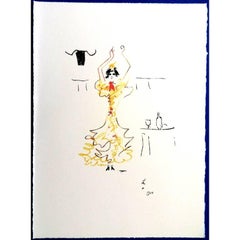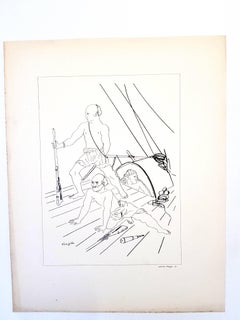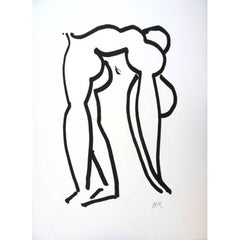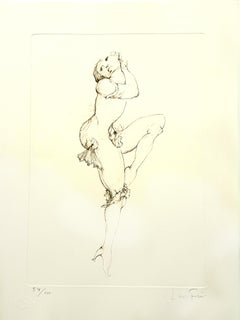Lithograph Nude Prints
to
61
149
76
69
17
6
Overall Width
to
Overall Height
to
318
117
109
50
49
42
32
12
10
2
1
1
1
34
15
15
15
13
1
7
280
30
2
3
30
25
7
66
38
24
34
2
1
232
85
247
143
129
125
66
65
63
49
41
12
8
7
7
6
6
5
5
4
4
4
318
194
100
54
34
46
86
191
115
Style: Modern
Medium: Lithograph
Marc Chagall - The Bible - Original Lithograph
By Marc Chagall
Located in Collonge Bellerive, Geneve, CH
Marc Chagall, Original Lithograph depicting an instant of the Bible.
Technique: Original lithograph in colours
Year: 1956
Sizes: 35,5 x 26 cm / 14" x 10.2" (...
Category
1950s Modern Lithograph Nude Prints
Materials
Lithograph
Marc Chagall - The Bible - Original Lithograph
By Marc Chagall
Located in Collonge Bellerive, Geneve, CH
Marc Chagall, Original Lithograph depicting an instant of the Bible.
Technique: Original lithograph in colours
Year: 1956
Sizes: 35,5 x 26 cm / 14" x 10.2" (sheet)
Published by: Édit...
Category
1950s Modern Lithograph Nude Prints
Materials
Lithograph
Jean Cocteau (after) - Carmen - Lithograph
By Jean Cocteau
Located in Collonge Bellerive, Geneve, CH
Lithograph after a drawing by Jean Cocteau
Title: Carmen
1971
Dimensions: 38 x 28 cm
Lithograph made for the portfolio "Gitans et Corridas" published by Société de Diffusion Artistique
Category
1960s Modern Lithograph Nude Prints
Materials
Lithograph
Leonard Foujita - Soldiers - Original Lithograph
Located in Collonge Bellerive, Geneve, CH
Original Lithograph by Leonard Foujita
Title: Soldiers
Signed in the plate
Dimensions: 23 x 28 cm
Edition of 97
From the " Propos d'un intoxiqué " Portfolio, published in 1928 by Jav...
Category
1920s Modern Lithograph Nude Prints
Materials
Lithograph
after Henri Matisse - Acrobat
Located in Collonge Bellerive, Geneve, CH
after Henri Matisse - Acrobat
Edition of 200
with the printed signature, as issued
76 x 56
With stamp of the Succession Matisse
References : Artvalue - Succession Matisse
Category
1950s Modern Lithograph Nude Prints
Materials
Lithograph
Leonor Fini - Dancing - Original Handsigned Lithograph
By Leonor Fini
Located in Collonge Bellerive, Geneve, CH
Leonor Fini - Dancing - Original Handsigned Lithograph
Les Elus de la Nuit
1986
Conditions: excellent
Handsigned and Numbered
Edition: 230
Dimensions: 38 x 28 cm
Editions: Trinckvel...
Category
1980s Modern Lithograph Nude Prints
Materials
Lithograph
Leonor Fini - Sadness - Original Lithograph
By Leonor Fini
Located in Collonge Bellerive, Geneve, CH
Leonor Fini - Sadness - Original Lithograph
The Flowers of Evil
1964
Conditions: excellent
Edition: 500
Dimensions: 46 x 34 cm
Editions: Le Cercle du Livre Précieux, Paris
Unsigned...
Category
1960s Modern Lithograph Nude Prints
Materials
Lithograph
Roger Chapelain-Midy - Original Handsigned Lithograph - Ecole de Paris
Located in Collonge Bellerive, Geneve, CH
Roger Chapelain-Midy
Original Handsigned Lithograph
Dimensions: 76 x 54 cm
Edition: HC XXI/XXX
HandSigned and Numbered
Ecole de Paris au seuil de la mutation des Arts
Sentiers Editi...
Category
1970s Modern Lithograph Nude Prints
Materials
Lithograph
Kees Van Dongen - Les Lepreuses - Original Portfolio with 26 Lithographs
Located in Collonge Bellerive, Geneve, CH
TITLE : Les Lepreuses (text by Heny de Montherlant)
EDITOR : NRF, Paris 1946
PRESENTATION : in-4 in leaves under slipcase
ILLUSTRATION : 26 original lithographs by Kees VAN DONGEN (w...
Category
1940s Modern Lithograph Nude Prints
Materials
Lithograph
Leonor Fini - Walking Dead - Original Lithograph
By Leonor Fini
Located in Collonge Bellerive, Geneve, CH
Leonor Fini - Walking Dead - Original Lithograph
The Flowers of Evil
1964
Conditions: excellent
Edition: 500
Dimensions: 46 x 34 cm
Editions: Le Cercle ...
Category
1960s Modern Lithograph Nude Prints
Materials
Lithograph
Leonor Fini - Fearless - Original Handsigned Lithograph
By Leonor Fini
Located in Collonge Bellerive, Geneve, CH
Leonor Fini - Fearless - Original Handsigned Lithograph
Les Elus de la Nuit
1986
Conditions: excellent
Handsigned and Numbered
Edition: 230
Dimensions: 38 x 28 cm
Editions: Trinckve...
Category
1980s Modern Lithograph Nude Prints
Materials
Lithograph
Leonor Fini - Playing - Original Handsigned Lithograph
By Leonor Fini
Located in Collonge Bellerive, Geneve, CH
Leonor Fini - Playing - Original Handsigned Lithograph
Les Elus de la Nuit
1986
Conditions: excellent
Handsigned and Numbered
Edition: 230
Dimensions: 38 x 28 cm
Editions: Trinckvel...
Category
1980s Modern Lithograph Nude Prints
Materials
Lithograph
Leonor Fini - The Cane - Original Handsigned Lithograph
By Leonor Fini
Located in Collonge Bellerive, Geneve, CH
Leonor Fini - The Cane - Original Handsigned Lithograph
Les Elus de la Nuit
1986
Conditions: excellent
Handsigned and Numbered
Edition: 230
Dimensions: 38 x 2...
Category
1980s Modern Lithograph Nude Prints
Materials
Lithograph
Leonor Fini - Rejection - Original Lithograph
By Leonor Fini
Located in Collonge Bellerive, Geneve, CH
Leonor Fini - Rejection - Original Lithograph
The Flowers of Evil
1964
Conditions: excellent
Edition: 500
Dimensions: 46 x 34 cm
Editions: Le Cercle du Livre Précieux, Paris
Unsign...
Category
1960s Modern Lithograph Nude Prints
Materials
Lithograph
Nude original Lithograph EA by Alain Bonnefoit
Located in Pasadena, CA
Original Lithographe EA (Epreuve d'Artiste ) Alain Bonnefoit’s trademark female nudes reflect both Western and Eastern art historical influences. A painter, engraver, and sculptor, B...
Category
Late 20th Century Modern Lithograph Nude Prints
Materials
Lithograph
Le repos du modèle
Located in London, GB
Henri Matisse
Le repos du modèle
1922
Lithograph on Chine appliqué on Japon paper, Edition of 575
Paper size: not listed
Image size: 22.2 x 30.4 cms (8 3/4 x 12 ins)
HM15512
Category
1920s Modern Lithograph Nude Prints
Materials
Lithograph
Leonor Fini - Thinking - Original Lithograph
By Leonor Fini
Located in Collonge Bellerive, Geneve, CH
Leonor Fini - Thinking - Original Lithograph
The Flowers of Evil
1964
Conditions: excellent
Edition: 500
Dimensions: 46 x 34 cm
Editions: Le Cercle du Livre Précieux, Paris
Unsigne...
Category
1960s Modern Lithograph Nude Prints
Materials
Lithograph
Leonor Fini - Red-Haired Girl - Original Lithograph
By Leonor Fini
Located in Collonge Bellerive, Geneve, CH
Leonor Fini - Red-Haired Girl - Original Lithograph
The Flowers of Evil
1964
Conditions: excellent
Edition: 500
Dimensions: 46 x 34 cm
Editions: Le Cercle du Livre Précieux, Paris
...
Category
1960s Modern Lithograph Nude Prints
Materials
Lithograph
Lithograph nude prints for sale on 1stDibs.
Find a wide variety of authentic Lithograph nude prints available on 1stDibs. While artists have worked in this medium across a range of time periods, art made with this material during the 21st Century is especially popular. If you’re looking to add nude prints created with this material to introduce a provocative pop of color and texture to an otherwise neutral space in your home, the works available on 1stDibs include elements of orange, yellow, blue, purple and other colors. There are many well-known artists whose body of work includes ceramic sculptures. Popular artists on 1stDibs associated with pieces like this include Mel Ramos, Leonor Fini, (after) Egon Schiele, and Apelles Fenosa. Frequently made by artists working in the Modern, Contemporary, all of these pieces for sale are unique and many will draw the attention of guests in your home. Not every interior allows for large Lithograph nude prints, so small editions measuring 0.04 inches across are also available Prices for nude prints made by famous or emerging artists can differ depending on medium, time period and other attributes. On 1stDibs, the price for these items starts at $11 and tops out at $1,500,000, while the average work can sell for $853.
